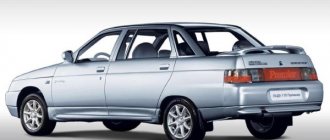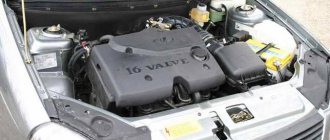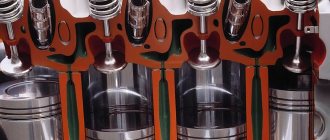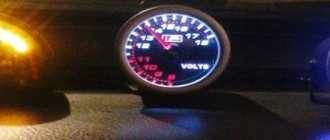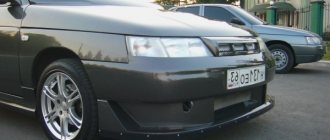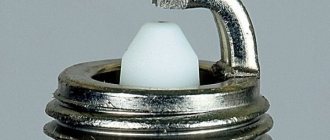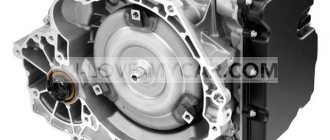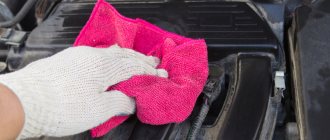When operating vehicles with different types of engines (gasoline, diesel), car owners often encounter an increase in oil consumption. At the same time, it is well known that in case of problems with the CPG, engine smoke is usually added to lubricant consumption.
However, it also happens that the oil level gradually decreases, but there is no blue or bluish oil smoke from the exhaust pipe. In this article we will talk about why oil consumption may be increased, but the engine does not smoke.
Read in this article
The engine oil consumption is increased, but the engine does not smoke: the main reasons
To understand why the engine eats oil but does not smoke, you need to study the possible causes of increased lubricant consumption.
First of all, if there is no oil smoke, but oil consumption is higher than normal, at first glance it may seem that there are no problems with the cylinder-piston group.
As a rule, drivers often attribute increased lubricant consumption without obvious engine smoking to poor oil quality. Some people also tend to believe that after driving at high speeds, an increase in consumption is completely normal.
Let us immediately note that in both the first and second cases certain losses are allowed, but if you have to add oil in liters every 2-3 thousand km. mileage, then it has nothing to do with the quality of the lubricant and the operating characteristics of the car.
- In other words, there are problems that need to be fixed. Most often, the main cause is an oil leak. At the same time, there is not always an obvious leak, when after parking you can notice drops of lubricant under the car. For this reason, when parking, you need to place a sheet of white cardboard under the car.
- In this case, a leak cannot be ruled out either, but determining the location of the leak will be even more difficult. So, whether there are stains under the car or not, we move on to the next stage, which involves a visual inspection of the engine compartment and engine compartment.
You should immediately inspect the valve cover gasket, as this problem is very common. If oil leaks are visible on the outside of the engine, then the problem is obvious. The solution is to replace the valve cover gasket or install fresh valve cover sealant.
- The next element to check are the seals. Both the front and rear crankshaft oil seals can leak. Camshaft seals also often leak.
At the same time, the condition of the seals itself is difficult to determine during external examination. A sure sign of an oil leak is “fogging” of the oil seals, heavy oiling at the place of their installation, etc. At the same time, it is necessary to change the engine seals faster. The fact is that in addition to loss of lubricant, oil can get on other parts and components.
- Often grease leaks from under the oil pressure sensor. In this case, the problem is usually not solved by simply tightening the sensor; the leak is eliminated by replacing the device. Also, lubricant leakage may be due to the fact that the oil filter is of poor quality or installed incorrectly.
By the way, on many internal combustion engines the oil pressure sensor is located above the oil filter. Visually, a sensor leak can be mistaken for leaks from under the oil filter housing, but replacing the oil filter with a new one does nothing. For this reason, before deciding to replace the filter, you need to make sure that the sensor is working properly.
- The camshaft plug, which can be found on engines with two camshafts or internal combustion engines with a single camshaft that do not have a distributor, deserves special attention during diagnostics.
The only thing is that if the plastic plug can be changed quickly and easily, then the rubber plug requires more precise installation in place in order to get rid of leaks and achieve the desired tightness.
- If the engine is equipped with a distributor, oil may leak through the O-ring. Replacing such a ring is not difficult, but then you will need to set the OZ.
A more difficult case is when oil gets into the distributor. The main symptom is a characteristic cracking sound (bearing cracks), as well as malfunctions of the distributor. In this case, the distributor will require disassembly, cleaning and replacement of the bearing along with the oil seal.
Why does Lada Priora “eat” oil?
Motor oil and its main functions
Main reasons for increased oil consumption
Despite the fact that the Lada Priora has an improved engine, it consumes a certain amount of engine oil. Oil consumption increases significantly if:
- there is a leak,
- parts are worn out,
- low-quality oil is used,
- oil service life has been exceeded,
- oil combustion,
- oil evaporation
The cause of oil leakage is poor crankcase ventilation. This happens when exhaust gases enter the crankcase through the joints of the piston rings. Excessive gas pressure occurs in the crankcase, which leads to the destruction of all processes in the lubrication system. The crankcase ventilation system is designed to remove these gases. After the gases are removed, the pressure returns to normal. But if the ventilation system channels are dirty, excess pressure will force the oil through the rubber seals. Therefore, it is so important to normalize the operation of the crankcase ventilation system.
The reason for wear of parts is operating the car in one mode: operating the car at high speeds for a long time. Therefore, it is recommended to switch to a lower engine speed mode, otherwise engine repair is inevitable.
Using low-quality oil. For any car, and Lada Priora is no exception, it is recommended to use the oil offered by the plant that produced the car. If you initially use synthetic oils, then it is possible to switch to another oil - semi-synthetic. Cheap mineral analogues are best used on low-speed engines, but not in Lada Priora.
The service life of the oil must not be exceeded, because This will cause the oil level to drop. During oil operation, the oil interacts with gases, fuel and rubbing parts, as a result of which it loses its properties.
Engine oil waste is the most common cause of losses.
A drop in oil level is a consequence of its evaporation process. This is caused by a change in the lubricating properties of the engine oil. Due to the fact that different brands of oils have different viscosities, they are recommended to be used under certain temperature conditions, which is also recommended by the manufacturer.
The problem of increased oil consumption can be partially solved by switching from synthetics to semi-synthetics. Semi-synthetics contain an additional number of additives and compensators, making them more practical and reliable.
Oil may burn due to worn valve caps. This problem can be diagnosed visually: blue smoke when the engine starts. In this case, the caps must be replaced. If this is not done in a timely manner, engine repair will be necessary. With a more thorough diagnosis of all Lada Priora systems, it is possible to identify the problem of why the car “eats” oil. The result could be any of the reasons discussed above. Therefore, timely elimination of the malfunction entails an extension of the engine service life. 08/02/2019
The manufacturer writes in the operating manual that the consumption of a certain amount of engine oil during normal engine operation is normal. This amount depends mainly on the quality and viscosity of the oil, as well as on the operating conditions of the vehicle. We decided to determine how many Lada car owners use oil and in what quantity...
AvtoVAZ installs the following engines on Priora, Grant and Kalina:
- VAZ-21116 (8cl, 1.6l, 87hp). Oil consumption rate: 50 g/1000 km.
- VAZ-21126 (16kl, 1.6l, 98hp). Oil consumption rate: 50 g/1000 km.
- VAZ-21127 (16cl, 1.6l, 106hp). Oil consumption rate: 50 g/1000 km.
- VAZ-21128 (16cl, 1.8l, 98hp). Oil consumption rate: 300 g/1000 km.
For the first three engines, oil consumption should not exceed 50g/1000km. The latest engine (VAZ-21128) is a modified version of the VAZ-21127 engine. The peculiarity of the 1.8 liter engine is that, while the block height remains unchanged, the piston stroke was increased (with a long-stroke crankshaft). This was achieved through the use of short connecting rods. This decision caused a high load on the connecting rod, walls, piston and rings. As a result of increased wear, the oil consumption of this engine can be up to more than 3 liters per 1000 km.
Engine oil consumption rates are indicated in information letter No. 62-12 of 2012. The maximum permissible oil consumption for VAZ car engines, excluding lubricant changes, is no more than 0.7 liters per 1000 km
vehicle mileage.
Reasons why Kalina, Granta and Priora eat oil:
- Unsuitable engine oil.
- Engine malfunction (worn oil seals or piston rings, etc..).
- Increased oil consumption may be due to driving the vehicle at high speeds with frequent acceleration.
- The pistons, piston rings and cylinder walls of the engine are not worn in (the engine is new or after a major overhaul).
Let us remind you that the oil consumption on the new VAZ-21129 and 21179 engines is different. What is the oil consumption on your Lada car? Have you encountered oil burns and how did you solve the problem?
What's the result?
As you can see, if the oil leaves, but the engine does not smoke, then the main problem is often a leak. You can also mention squeezing out oil through the breather, etc. However, it is not always possible to detect a leak during a visual inspection. In some cases, partial disassembly, removal of protective covers in the engine compartment, etc. may be required.
As for repairs, in some cases the problem can be fixed quickly and at minimal cost. However, if the crankshaft oil seals begin to leak (especially the rear SCV), then replacement involves a whole range of work and requires certain professional skills.
Why oil leaks from the engine breather: signs and main causes of such a malfunction. How to understand why oil is flowing through the breather, troubleshooting.
Why the oil pressure light comes on after the engine warms up: the main reasons. What should a driver do if the oil pressure comes on when the engine is warm.
Why oil leaks from a car engine: causes and signs of a motor oil leak. What should the driver do and how to find the place where the oil is leaking from the internal combustion engine.
Oil leak through breather
Oil loss through the breather is a very unpleasant problem. A breather is a device that compares the crankcase pressure of a power plant with atmospheric pressure. Without it, air would not get into the engine at all. Reasons for this malfunction:
- Air filter condition. The engine simply doesn't have enough air.
- Filling the lubrication system above a certain level. The excess is simply squeezed out through the breather.
- Worn oil scraper rings. As a result, excess pressure appears in the engine crankcase, which expels oil through the breather.
If the first two faults are easy to deal with, then the third one will have to go to a service station. Very rarely, the oil deflector rod may become clogged. In this case, gasoline and oil vapors do not pass into the oil separator, but are deposited in the breather, and a characteristic smell of gasoline is present.
Allowable flow
You can say that a car consumes oil in excess of the norm if the consumption of the lubricant mixture does not correspond to the volume specified by the manufacturer. This parameter is determined by the engine size (depending on the number of pistons in the power unit). Table 1 illustrates the approximate oil consumption for waste with a working engine, taking into account the use of high-quality lubricant.
Table 1. The volume of motor fluid lost to waste after 8-10 thousand vehicle mileage*.
| Engine volume, l. | Amount of oil for waste, ml. |
| 1-1,6 | 150-200 |
| 1,8-2,5 | 180-250 |
| 2,5-3,5 | 200-300 |
*The table shows average values, see the operating instructions for your car for exact figures. For some models, the consumption rate will be several times higher.
If your car consumes more engine mixture than the amount indicated in Table 1, then you need to find out where the oil goes.
Motorists often ask: “Why does the engine burn oil but not smoke?” This phenomenon is quite strange - smoke is one of the criteria confirming excessive consumption of motor fluid. If the driver claims: the car eats a lot of oil, but does not smoke, then he is mistaken - the characteristic blue smoke appears only when the engine is loaded, while it completely disappears in neutral or park gear. Ask someone to drive your car and you will see that when accelerating or changing gears, the vehicle smokes - oil gets into the combustion chamber of the engine. We will give below the most common reasons why a car eats engine oil and, according to the owner, does not smoke at all.
You can also see why the engine overuses oil and does not smoke in the video:
Preface
If the systems operate normally, no more than 1 liter of lubricant should burn out per 10 thousand kilometers. Even when the engine consumes 2–2.5 liters of oil for this mileage, it is still too early to worry. But with a larger number, you will have to draw conclusions, find out the cause and eliminate it.
The working fluid level is determined with a special dipstick. If it is lower than required, there may be leakage to the outside, which is easier to determine. Before you understand where the lubricant leaks and what to do about it, find out how oil extends the life of the engine.
Piston ring wear
Remove the dipstick that measures the oil level, start the engine and see if crankcase gases are released from the dipstick hole. If white or blue smoke comes out through the hole, then the engine mixture enters the cylinders, the gases enter the crankcase through the piston rings. If there is no characteristic blue smoke, check the compression in the cylinders.
When piston rings wear out, motor oil consumption can reach up to 1 liter per 1 thousand km. There are several types of piston ring wear:
- Abrasion of the outer side of the ring, which rubs against the cylinder walls. This leads to an increase in the gap between the cylinder and the ring.
- Reducing the thickness of the ring, it becomes thinner and moves freely along the piston groove. Reduced piston rings begin to throw the engine mixture towards the combustion chamber, increasing fluid flow. Such wear of the rings leads to very high oil consumption by the engine.
- The use of low-quality motor oil, leading to coking of the piston rings and a decrease in compression in all cylinders of the power unit.
Deterioration of the valve stem seals, wear of the liners
Look at the operation of the power unit at idle speed.
If the caps are worn out, the car eats a lot of oil. At the same time, but at idle it does not smoke or produces a small amount of smoke. If large clouds of blue smoke appear when you press the accelerator pedal hard, this indicates wear on the caps. In most cases, excessive consumption of engine mixture through worn caps does not occur; less than 500 ml of oil per 1 thousand km must be added. If oil consumption increases, the piston rings need to be replaced.
The deterioration of the condition of the caps is also indicated by velvety carbon deposits on the spark plugs and interruptions in engine operation. Such phenomena occur if the cuffs of the valve stem seals harden or if they are significantly worn, and they do not provide the required seal and lead to free flow of oil under the guide bushing, along the valve stem.
If, while checking the oil level in the engine, you notice shiny small particles in the engine fluid, this indicates wear on the liners.
Owner reviews
- Autoreview magazine during life tests of the Lada XRAY with a 1.8 liter engine in 2016 (it took 5 liters per 10,000 km);
- magazine "Behind the Wheel" (over 2500 km, the oil level of the Lada Vesta with a 1.8 liter engine dropped from the middle to below the minimum level).
It is noteworthy that during the life tests of Vesta, no increased oil consumption was noted on the 1.6-liter engine.
Survey
among owners of Lada Granta, Lada Kalina, Lada Priora. Engine 1.6 l:
Survey
among owners of Lada Vesta and Lada XRAY. Engine 1.6 and 1.8 l (link to survey):
Your reviews on oil consumption on LADA car engines
leave it in the comments.
Where does the oil go?
The correct operation of an internal combustion engine largely depends on a sufficient amount of lubricant. It is used to reduce friction between moving parts. The greatest friction, as a rule, is in the piston group of the power unit. Since a high temperature is constantly maintained in the internal combustion engine, a certain part of the lubricant burns, being removed with the exhaust gases or deposited on the walls of the combustion chamber, valve seats or on the piston rings.
The figures mentioned above regarding engine oil consumption are approximate: for each car this indicator is strictly individual and is prescribed by the manufacturer in the technical documentation for the vehicle.
High fuel consumption, complaints “the car is eating lubricant” are a sign of engine malfunction. The main reason in most cases is simple wear and tear. The first signs are the appearance of liquid in the ventilation system, from where, in the absence of proper care and repair work, it enters the air filter. This happens due to the increase in crankcase gas pressure, which increases as the engine wears, which pushes lubricant into the breather.
A turbocharged engine consumes liquid in huge quantities in most cases due to wear on the turbine rotor bushings. Accordingly, it is important for owners of such cars not only to monitor the condition of the engine, but also the turbine.
Useful information about violations of lubricant consumption in a car
Motor oil and its main functions
The technical documentation of the car clearly states the required consumption of oil and other consumables.
The technical documentation of each car indicates specific figures for the consumption of a particular fluid used by the vehicle’s systems. Motor oil is no exception to this list. However, sometimes problems arise in the operation of the car, one of which is increased oil consumption.
Motor oil is an important part necessary for the full and efficient operation of all systems. Not a single mechanical system, such as an engine, can fully function without lubricating fluids. During operation, many interconnected mechanical processes occur in the motor. As a result, friction occurs between the moving elements, which has a destructive effect on the parts of the motor and its functionality. Motor oil is designed to compensate for all the negative effects caused by friction and prevent functional wear of parts.
A decrease in oil level or its increased consumption leads to the fact that moving parts cannot fully perform their functions due to insufficient lubricating fluid. Parts begin to wear out, and mechanisms jam and fail. Therefore, monitoring the oil level and its quality is the most important task to ensure continuous and long-lasting operation of the vehicle.
Reasons for increased oil consumption
There may be several reasons why the power unit consumes lubricant. The most common reason that Priora eats lubricant is low-removable caps. They are installed in the valves of the gas distribution system. You need to deal with them carefully, as unusual situations may arise. For example, the likelihood of hardening of the cap seals increases significantly due to a poorly warmed-up engine, which is especially true for priors with high mileage. A frozen cuff will not fit tightly enough into place, causing lubricant to flow freely under the bushing. The result of this will be either lubricant entering the combustion chamber or into the exhaust system, followed by the formation of carbon deposits on the spark plugs or interruptions in engine operation.
What kind of scratch remover is this?
We constantly receive questions in the comments about what kind of “liquid glass” products this is, and in general what a bunch of auto-related advertising is now on the market. As a result, we decided to test in practice how true this is. Let's just say we used 3 means. One product proved to be so-so; after application, a burnt spot remained in this place. The second product, when applied, showed no effect at all.
The third product, SILANE GUARD, at first it was also felt that there would be no effect. but nevertheless, after the solution remained on the surface for several minutes, the effect was excellent. Of course, everything is not as beautiful as advertised.
We had a discussion at a local service station, they said that the products are effective, but they should be used only according to the instructions. And not as anyone pleases.
Troubleshooting Methods
The first thing to do is to find possible leaks by carefully inspecting the valve cover. If there are leaks on the engine oil pan, drain the oil, then unscrew the pan and change its gasket, preferably placing it on sealant. If there is a leak through the crankshaft seals, replacing them yourself will be very problematic. It is better to carry out repairs at a service station.
Another reason for increased consumption may be a clogged crankcase ventilation system. Over time, resin deposits and carbon products are deposited on the walls of the pipe, which makes it difficult to remove gases that have escaped from the combustion chamber. This creates excess pressure in the crankcase, which forces oil through the seals and seals. Oil mist will enter the combustion chamber in excess through the ventilation system and intake manifold, which will lead to a decrease in the calorific value of the fuel and loss of engine power. To prevent this problem, it is necessary to regularly clean the ventilation system pipes: approximately every 50 thousand kilometers.
You should be careful about the quality of the lubricants used. They must comply with those recommended by the manufacturer, taking into account the climatic zone of the vehicle's operation. By following all the necessary recommendations, eliminating the indicated malfunctions and abandoning an aggressive driving style, you can significantly reduce the consumption of fuel and lubricants in your car.
Piston rings
Another reason why a car eats special fluid is the piston rings. Each piston has three rings - an oil scraper ring on the bottom and two compression rings on top. The automaker uses compression rings to reduce the distance between the cylinder wall and the piston itself, thereby achieving maximum energy transfer to the engine. To reduce the friction created, lubricating fluid is supplied to the compression rings, which is then removed by oil scraper rings. The wear of these rings is the reason why the Priora eats the special fluid - they simply leave excess lubricant on the cylinder walls. So the reason for increased waste of lubricant may be piston rings, but not always engine malfunction.
Over the course of its entire “life,” Priora is subjected to a huge number of heating-cooling cycles. Accordingly, a high load falls on all components and parts of the motor. A decrease in the elasticity of the piston rings or their wear can cause a phenomenon such as flutter. This phenomenon has been poorly studied, but it is known that during engine operation, the rings move around the piston radius with a certain frequency, but at the same time they can jump from one edge of the piston groove to the other. Such sharp jumps are the reason that the Priora eats large quantities of lubricant, but does not smoke, although a clear sign of such a malfunction is the bluish-colored exhaust smoke.
Low quality motor lubricant
The reason that the engine consumes liquid may be low quality lubricants or the wrong type. For each car, including the Priora, there is a certain type of lubricant, but if it is selected incorrectly, consumption jumps sharply. For example, reduced viscosity can cause the piston rings to be unable to collect all the lubricant, causing it to settle on the cylinder walls and burn along with the fuel. As a result, combustion products either come out along with the exhaust in the form of bluish smoke, or settle in the form of soot on the spark plugs. The consequence may be coking of the rings, when the liquid settles in a thick layer on the engine components.
Why is lubricant quickly used up?
"Priora", despite its modern engine, "eats" a lot of oil. The reasons for this are as follows:
- the appearance of a leak;
- wear of spare parts;
- low quality motor oil;
- exceeded operating period;
- burning of oil liquid.
Often, car oil leaks occur due to poor crankcase ventilation. This happens because the exhaust enters the crankcase through the piston rings. Gases create increased compression, which disrupts the normal flow of processes in the unit. The oil is simply squeezed out of the engine.
Why do Priors eat oil, besides the reasons listed above? Oil is probably leaking from the valve plug or oil filter. To eliminate such leaks, the lining must be replaced. Constant vibration exposure, high loads, trips over rough terrain - all this causes various leaks.
Synthetics have good viscosity characteristics, ensuring the uninterrupted functioning of all units. It contains many additives that soften and partially eliminate the consequences of the negative impact on the power unit.
Mineral water does not have the advantages of synthetics. It pollutes the lubricating complex with its own combustion products. As a result, it turns out that the car “eats” oil.
An excessive operating period may also be the reason that the machine eats oil. Since the characteristics of the motor oil deteriorate during operation, some of the lubricant evaporates and burns out.
This negatively affects the car engine. Timely measures taken will allow the power unit to operate without failures for a long time.
Natural wear and tear
The reason that a car eats lubricant may also be banal natural wear and tear of the engine and all components. As a result, the lubricant will be consumed several times faster than during normal vehicle operation. Engine wear can cause both deformation of the cylinder walls and the appearance of chips and cracks, burning of gaskets and failure of oil seals. Motor fluid can be deposited in engine components, but it can be too difficult to determine its exact excess consumption - it depends on the level of wear of the power unit and other vehicle systems.
Reason one
If, after running the engine at idle speed for several minutes, you press the gas pedal to the floor a couple of times, a cloud of bluish color may burst out of the exhaust pipe. With an increase in the number of presses, it will disappear, but this is a clear sign that there are problems with the valve stem seals. Oil leakage while the engine is idling and its sudden combustion in the combustion chamber leads to the appearance of bluish smoke and, accordingly, an increase in its consumption. However, replacing the caps does not always solve the situation: often the problem can be in the valve bushings - it is advisable to change them together with the caps.
Reason two
The appearance of bluish smoke while going uphill, when you have to constantly press the gas pedal. At the same time, the driver may not see the bluish haze as such, but it is clearly visible to the “colleagues” driving behind. Such a thin stream of blue smoke is a sure sign of a malfunction of the piston system and increased engine oil consumption. Many auto repairmen are of the opinion that increased waste of lubricant on the highway is a problem with the piston system, which may include the following:
- Piston rings and their wear.
- The groove for the piston rings is worn out.
- Occurrence of piston oil rings. Eliminated by adding additives.
- Incorrect placement of compression rings. Eliminated by removing carbon deposits or adding additives.
- Exit from standing cylinders. Leads to decreased engine compression. It can be eliminated either by lining or by boring the cylinder. There is a minus: the engine life is reduced.
- Piston failure. It can only be eliminated by installing new ones.
The problem of the Priora “smoking” can be solved by simply adding additives to the special fluid or fuel that eliminate the occurrence of piston rings. If this does not help, you can use the old method: fill the cylinders with acetone diluted with engine lubricant and kerosene. After this, a day later, the mixture is drained and a new lubricant is poured. If this does not help, then all that remains is to disassemble and clean the engine.
Useful information about engine lubricant consumption Reason three
The car smokes a lot or there is no definite pattern in the appearance of smoke. In the case of turbocharged engines, the cause of the appearance of bluish smoke may be a malfunction of the turbine, the system for changing the geometry of the intake manifold or the crankcase ventilation system, in the case of a diesel engine - lagging injection of the fuel mixture.
- Turbine failure. The reason for this may be the destruction of the oil seal in the turbocharger, as a result of which the lubricant will burn in the exhaust pipe. As a rule, it flows very abundantly, so that it can even drip from the muffler.
- Damage to the ventilation system. The use of low-quality motor fluid often leads to its complete destruction. The products of its destruction are deposited on the internal surfaces of the engine, forming so-called carbon deposits. A large amount of carbon deposits clogs the oil separator, which leads to a deterioration in the process of purifying crankcase gases from lubricant. As a rule, highly accelerated engines accumulate a large amount of it and then dump it into the cylinders. Such discharges lead to the release of large amounts of bluish smoke. These signs indicate a malfunction of the ventilation system.
- Fluctuations in the geometry of the intake manifold. Some engine models have a design in which the drive of the overlapping air channels of the dampers is located inside. Accordingly, oil mist accumulates there. If the servomotor breaks down, lubricant from the engine enters the intake manifold. This results in blue smoke. This is eliminated by turning off the servomotor and eliminating the geometry as such. The damper axles will naturally stop moving freely, which will reduce fuel waste. The reason for this is most likely that the gaps between the head housing and the axles are clogged with carbon deposits, which reduces leakage.
Do I need to change the oil when consumption is high?
Often, car enthusiasts, after diagnosing high waste of motor fluid, wonder: is there any point in completely changing it or is it enough to just finish it off from time to time? The main argument in favor of the fact that it is pointless to carry out a complete lubricant change is that during the service period the same amount of lubricant passes through the engine.
In fact, a complete replacement must be carried out in accordance with the technical documentation. The main function of the lubricant is to reduce friction and clean engine components from combustion products. As a rule, they settle either in the pan or in the oil filter, but are not removed. Over time, the amount of carbon deposits increases, and constant addition of lubricant only compensates for the amount of contaminated lubricant.
